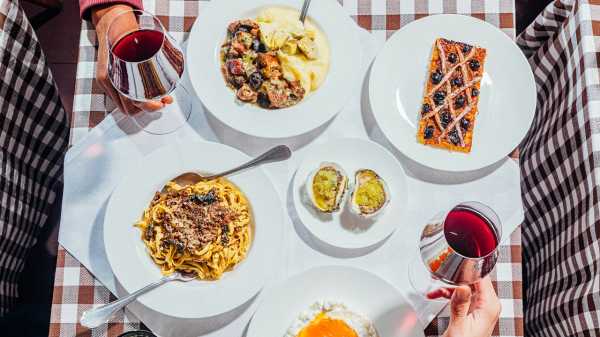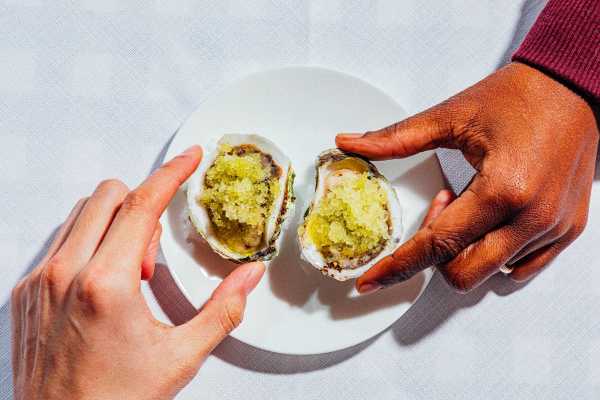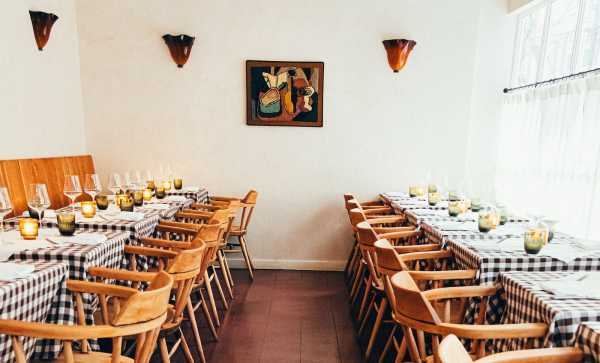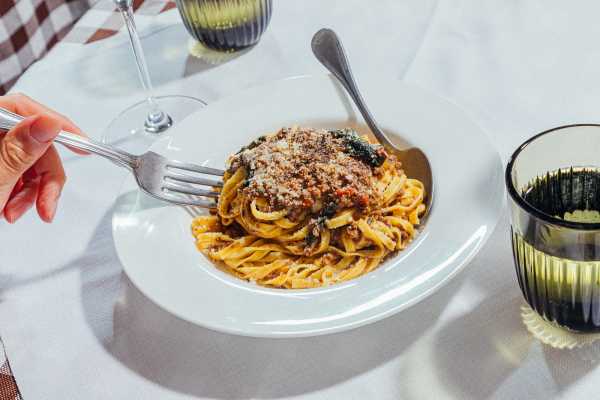
Save this storySave this storySave this storySave this storyYou’re reading the Food Scene newsletter, Helen Rosner’s guide to what, where, and how to eat. Sign up to receive it in your in-box.
We always have plenty of Paris, here in New York—the bistros, the brasseries, the gilded pâtisseries, an entire city within a city mimicking, to various degrees of accuracy, the City of Light. It’s less common to find a place that strays beyond the edge of town, out past the banlieues, maybe into another bit of the country entirely—a shame, really, since it’s not like the balance of France is a culinary wasteland, and I wonder sometimes if Manhattan will collapse under the weight of yet another red-and-gilt bistro. This is all to say that the time feels ripe for a restaurant like Zimmi’s, a very French—and very Provençal—little spot that opened in December, with a kitchen run by the American (but solidly French-pedigreed) chef Maxime Pradié, who draws inspiration from summers spent in the South of France, learning to cook with his grandmother.
Zimmi’s occupies a tiny, charming storefront positioned on a tiny, charming corner of the West Village. Its large, wall-size windows, their casements painted a downy shade of white, look out across Bedford Street onto a row of old and characterful brownstones, including number 75½, whose façade, at nine and a half feet across, is allegedly the city’s narrowest (and therefore most charming). The restaurant’s interior is cramped, in a warm and elegant sort of way; past the scrum at the host stand is a pint-size bar, and a brief field of tables beyond. The restaurant is the creation of the longtime hospitality pro Jenni Guizio, formerly a beverage director at Union Square Hospitality Group, who here is stepping for the first time into the role of proprietor. Alumni of that group run some of the city’s most pleasing-to-be-in establishments, which tend to share a common welcoming temperament more than a particular culinary signature. At Zimmi’s (which Guizio named for the famed American designer and metalworker Marie Zimmermann—not very Provençal, but what’s in a name, anyway), it shows in the details, and the ways the details shape the mood. The music is low and happy, the brown gingham tablecloths disarmingly chic—and conversations struck up with strangers are of the “Oh, God, is that the lamb, it looks divine” variety.

Oysters with celery granita.
You’ll start your meal with something snacky—pissaladière, most likely, the famous Niçoise tart of caramelized onions, anchovies, and briny black olives as small and luminous as beads of jet, here portioned into a rectangle the size of a playing card. Its particular flavor equation—sweet, briny, buttery, and sharp—is a hallmark of Provençal cooking, bringing together the influences of Italy right next door and the Mediterranean just ahead. It’s a combination that shows up again in the ratatouille, which is not, here, the carefully laid-out tian made famous in the Pixar movie but a proper mush of long-cooked vegetables (including wintry selections such as pumpkin and fennel) entangled lustily in a scoop atop a plain white salad plate. Pradié stews each element separately, for clarity of flavor, and then finishes them together, to meld their individual tones. The result is vegetables of a resonant, caramel florality, with a nose-scrunching splash of vinegar tying it all together. It’s an understated showstopper, especially when paired with an order of the kitchen’s dense, well-crusted sourdough, one of the nicest loaves I’ve had in a while—at twelve dollars for a few modest slices, it ought to be, and you can make up the cost by skipping the barbajuan, crisp little pillows stuffed with greens and cheese, which sound sweet and look darling but taste faint as a memory.

The storefront space is cramped but elegant, with gingham tablecloths covering closely spaced tables.
There’s traditional luxury to be had, if you’re looking for that sort of thing—a truffle-laden pasta special one night, toast soldiers piped with foie-gras mousse and topped with a jiggly squish of Sauternes jelly on another. But there’s just as much sumptuousness to be found in humble preparations such as the terrine du potager, a slice of tender winter vegetables, chilled and gently aspic-bound, arranged chromatically—white leek shading into green leek, into orange carrot, into red pepper—plated next to a dollop of anchovy aioli; or in the lentils, which are braised to a texture as firm yet unctuously yielding as any caviar pearls. (The menu’s only side dish, besides the inevitable French fries, it doesn’t quite fit into any course, and it absolutely should not be missed.) The thrill of these offerings is a matter of philosophy as much as of technique: sure, we all swan around the farmers’ market and covet membership in Rancho Gordo’s bean club, but it still feels a bit rebellious for a restaurant to dedicate so much of a menu to vegetables and legumes, to lavish them so royally with respect, butter, and time.
Meat, too, is prepared with palpable reverence. Pradié presents boeuf bourguignon not as a bowl of stew but as a graceful plated course, with big, tender morsels of beef (cheeks, when I visited) positioned atop a swirl of the wine-based sauce in which they were braised, with a jagged skyline of goodies from the pot: pale pink radishes, glossy hunks of smoky lardons, a pair of carrots as long and slim as dancers’ legs. Duck à l’orange, that nineteen-sixties classic, is punched up with a doubling of citrus sauces: a puddle of the expected sauce bigarade, a chestnut-colored gastrique with demi-glace and orange liqueur, laps up against a yellow pool of sauce maltese, which is something like a hollandaise spiked with orange juice. The main courses have been changing often; I wanted to revisit a lamb stew I’d been enthralled by, dark shreds of meat punctuated with black olives and served over a whip of mashed potatoes, but by the time I returned to Zimmi’s two weeks later it was gone. Other parts of the menu—the pissaladière, the ratatouille—seem to remain happily available from one visit to the next.
Helen, Help Me!
E-mail your questions about dining, eating, and anything food-related, and Helen may respond in a future newsletter.

The pastasciutta, one of two pastas on the menu, features fresh tagliatelle in a ragout of chicken parts.
One of the items that’s stayed put on the menu, and hopefully will forever, is the pastasciutta, one of two pasta preparations on the menu. Inspired by one of Pradié’s grandmother’s recipes, the long tagliatelle are tossed in a thin, beigey ragout of chicken parts (liver, heart, gizzard: all the good bits). It doesn’t look or sound like much—“pastasciutta” simply indicates pasta tossed in sauce—but it tastes like kissing God full on the mouth. Chicken liver is one of the great secret pasta-sauce ingredients—its fatty, meaty, ferric flavor creates instant depth in any ragù (or ragout)—but here it claims its rightful spotlight, like Debbie Reynolds stepping out from behind the curtain at the end of “Singin’ in the Rain.” A whole restaurant could be carried on the brilliance of a dish like this one, but the truth is that, besides the boring barbajuan, I struggled to find a single thing at Zimmi’s that I didn’t wholly adore. There’s a nice ice cream for dessert, with flower-shaped shortbread cookies; there’s a marshmallow-white circle of rice pudding studded with almonds and smeared with jammy persimmon, my ordering of which prompted a stranger next to me at the bar one evening to launch into a rhapsody about the rice puddings of his childhood. What is it about the food of Provence that seems to conjure, so universally, these feelings of warmth and home? We’ll always have Paris. Now we’ve got Zimmi’s, too. ♦
Sourse: newyorker.com







